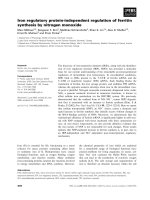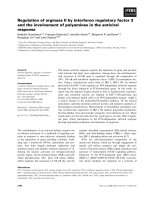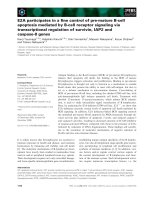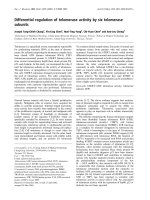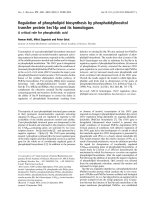Regulation of floral patterning by flowering time genes
Bạn đang xem bản rút gọn của tài liệu. Xem và tải ngay bản đầy đủ của tài liệu tại đây (25.12 MB, 273 trang )
REGULATION OF FLORAL PATTERNING BY
FLOWERING TIME GENES
LIU CHANG
(B.Sc. (Hons.), NUS)
A THESIS SUBMITTED
FOR THE DEGREE OF DOCTOR OF PHILOSOPHY
DEPARTMENT OF BIOLOGICAL SCIENCES
NATIONAL UNIVERSITY OF SINGAPORE
2009
Acknowledgements
i
Acknowledgements
I would like to express my sincere gratitude and appreciation to my supervisor,
Associate Professor Yu Hao for having given me such great opportunity to work on
this project, and for his constant guidance and unfailing support and encouragement
throughout the course of my studies in his laboratory.
I would like to thank Professor Prakash Kumar for his valuable comments on my
experiments and support. Special thanks to Dr. Toshiro Ito for providing me mutant
seeds, which made my project move faster, and to other lab resources shared with us.
During my course, I received Research Scholarship from Department of Biological
Sciences in NUS and Singapore Millennium Foundation. I am extremely grateful for
these financial supports.
I also would like to thank Xi Wanyan, Shen Lisha and Tan Cai Ping for their help and
support to make this story complete. In addition, thanks to my collaborators Li Dan,
Chen Hongyan, Zhou Jing, Er Hong Ling, Thong Zhonghui, Ng Jai Hui, Wu Yang, for
their help and sharing in other projects that were not written in this thesis. Thanks to
my fellow lab members Xingliang, Wang Yu, Candy, Tao Zhen, Fang Lei, Liu Lu,
Wang Yue for their help and friendship.
Last but not least, I feel grateful for my parents, for their love and parenting since I was
born. Finally, I would like to thank my wife, Wanyan, for her love and encouragement
throughout.
December 2009
Liu Chang
Table of Contents
ii
Table of Contents
Acknowledgements i
Table of Contents ii
Summary v
List of Tables vii
List of Figures viii
List of Abbreviations and Symbols xi
Chapter 1 Literature Review 1
1.1 Prerequisite: a switch for the formation of inflorescence meristems 3
1.1.1 Flowering pathways 5
1.1.2 Floral pathway integrators 8
1.1.3 Candidates for new floral pathway integrators 10
1.1.4 Regulation of flowering time by central repressors 12
1.2 Protruding out: an integrative programme for initiation of floral meristems 14
1.3 Acquisition: regulation of floral meristem identity genes 20
1.4 Maintenance: a key balance towards floral patterning 24
1.4.1 Repression of cryptic bract 25
1.4.2 Repression of floral reversion 26
1.4.3 Repression of floral homeotic genes 35
1.5 The MADS protein family 41
1.6 The domain structure and function of MIKC type MADS protein 43
1.6.1 The MADS domain 43
1.6.2 The K box 44
1.6.3 The I region 45
1.6.4 The C region 46
Chapter 2 Materials and Methods 47
2.1 Plant materials and growth conditions 48
2.2 Plasmid construction 48
2.2.1 Cloning 48
2.2.2 Verification of clones using PCR 50
2.2.3 Sequence analysis 51
Table of Contents
iii
2.3 Plant transformation 52
2.3.1 Electroporation 52
2.3.2 Floral dip 52
2.3.3 Plant selection 53
2.3.4 Genotyping 53
2.4 Expression Analysis 54
2.5 ChIP Assay 55
2.5.1 Nuclear fixation 55
2.5.2 Homogenization and sonication 55
2.5.3 Immunoprecipitation 56
2.5.4 DNA recovery 57
2.5.5 Calculation of fold
enrichment 58
2.6 In Vitro Pull-Down Assay 59
2.6.1 Protein expression and harvest 59
2.6.2 In vitro pull-down 60
2.7 Coimmunoprecipitation 60
2.8 Western blot 61
2.9 BiFC analysis 62
2.10 Antibody production 63
2.11 Non-radioactive in situ hybridization 63
2.11.1 Preparation of RNA probes 63
2.11.2 Tissue Fixation 64
2.11.3 Dehydration 65
2.11.4 Staining 65
2.11.5 Embedding 66
2.11.6 Sectioning 66
2.11.7 Section pretreatment 67
2.11.8 Hybridization 68
2.11.9 Post hybridization 68
Chapter 3 Results 74
3.1 SOC1, AGL24, and SVP redundantly regulate flower development 75
Table of Contents
iv
3.2 Class B and C genes are deregulated in soc1-2 agl24-1 svp-41 83
3.3 SEP3 is repressed by SOC1, AGL24, and SVP 95
3.4 SOC1, AGL24, and SVP directly repress SEP3 via binding to a common
promoter region 105
3.5 Ectopic SEP3 activity results in ectopic expression of class B and C genes .113
3.6 SEP genes activate the expression of class B and C genes 120
3.7 SEP3 and LFY act in concert to activate the expression of class B and C genes
121
3.8 SOC1 and AGL24 interact with SAP18 132
Chapter 4 Discussion 151
4.1 Control of floral patterning by flowering time genes 152
4.2 Transcriptional activation of class B and C genes by SEP3 and LFY 153
4.3 Regulation of SEP3 expression by SOC1, AGL24, and SVP through recruiting
different chromatin factors 155
References 158
Appendix 181
Summary
v
Summary
In plants, the floral transition is regulated by flowering time genes, which determine
how fast plants enter the reproductive phase. During the course of flower development,
floral homeotic genes control floral patterning, which determines proper floral organ
identity. Yet it is unclear whether flowering time genes have an impact on flower
development. During my graduate course, I discovered that combined mutations of
three Arabidopsis flowering time genes, SOC1, SVP, and AGL24 produced amazing
floral defects. I thought that such a novel phenotype might allow me to re-evaluate the
functionality of flowering time genes, and achieve a more in-depth understanding on
flower development control.
In a soc1-2 agl24-1 svp-41 triple mutant, I show that the establishment of floral
patterning is mis-regulated. Class B and class C floral homeotic genes are precociously
activated in floral primordia. More importantly, a key floral homeotic gene, SEP3, is
derepressed throughout the plant including the emerging floral primordia, and it
interacts with LFY to precociously activate class B and C genes. Thus, floral primorida
in the soc1-2 agl24-1 svp-41 triple mutant with insufficient number of meristem cells
are compelled to enter the floral organogenesis program, which results in reduced
number of floral organs and deregulation of floral organ identities. Besides, I also
extended our understanding on the function of SEP gene famility with the discovery
that they are redundantly required to establish floral patterning. The molecular
mechanism of SEP3 repression was further explored by studying protein parterners
interacting with these flowering time regulators. SAP18 was identified as the protein
Summary
vi
partner of SOC1 and AGL24; it is one of the core components of histone deacetylation
complex. Further studies have shown that the repression of SEP3 by SOC1 and AGL24
is mediated by deacetylation of histon H3 in SEP3 promoter. On the other hand, TFL2,
which is required to maintain tri-methylation level on histon H3 Lysine 27 in SEP3
promoter region, was identified as the partner of SVP. These results indicate that tight
regulation of SEP3 by the three flowering time genes is an essential step defining
spatial and temporal expression of floral homeotic genes, and thus provide important
insights into the new function of flowering time genes and the orchestration of early
flower development programme.
List of Tables
vii
List of Tables
Table 1. Members of StMADS11-clade MADS-box genes that affect FM development.
31
Table 2. Arabidopsis genes that prevent precocious activation of floral homeotic genes.
36
Table 3. Primers used in this study. 71
Table 4. Number of floral organs in mutants and wild-type plants. 77
List of Figures
viii
List of Figures
Figure 1. Appearance of Arabidopsis FMs 4
Figure 2. Regulation of FM identity genes by FT and SOC1 that integrate multiple
flowering signals 6
Figure 3. FM initiation is regulated by auxin and meristem polarity. 16
Figure 4. Maintenance of FM identity through balancing FM indeterminacy and
differentiation 28
Figure 5. Floral defects of soc1-2 agl24-1 svp-41. 76
Figure 6. Homeotic transformation of floral organs in soc1-2 agl24-1 svp-41. 80
Figure 7. Scanning electron microscope analysis 81
Figure 8. Complementation of soc1-2 agl24-1 svp-41 by the genomic fragment of
SOC1, SVP, or AGL24. 82
Figure 9. In situ localization of class A homeotic genes in soc1-2 agl24-1 svp-41. 84
Figure 10. In situ hybridization showing ectopic expression of class B and C genes in
soc1-2 agl24-1 svp-41. 85
Figure 11. In situ localization of class B and C genes in the double mutants. 86
Figure 12. In situ localization of WUS 89
Figure 13. In situ localization of class B and C genes in plants at the vegetative stage.
90
Figure 14. In situ localization of class B and C genes in plants at the reproductive stage.
91
Figure 15. In situ localization of AP3 and AG in serial sections of inflorescence apices
of soc1-2 agl24-1 svp-41 after bolting. 92
Figure 16. Ectopic activities of AP3 and AG in soc1-2 agl24-1 svp-41 are partially
independent. 94
Figure 17. Class B and C homeotic genes are not directly regulated by SOC1, SVP, or
AGL24. 96
Figure 18. In situ localization of SEU and LUG in soc1-2 agl24-1 svp-41 98
Figure 19. In situ localization of SEP3 in plants at the reproductive stage. 99
Figure 20. In situ localization of SEP3 in plants at the vegetative stage 100
List of Figures
ix
Figure 21. Expression fold change of floral homeotic genes in vegetative tissues. 102
Figure 22. SEP3 expression in 6-day-old whole seedlings 103
Figure 23. Repression of SEP3 by constitutive expression of SOC1, SVP, or AGL24.
104
Figure 24. In situ localization of SEP3 in serial sections of inflorescence apices of
various mutants 107
Figure 25. Direct Binding of SOC1, SVP, and AGL24 to SEP3 promoter. 108
Figure 26. Specificity of anti-AGL24 antibody 111
Figure 27. Mutagenesis of a typical SEP3 throughout the inflorenscene apices. 112
Figure 28. Floral defects of soc1-2 agl24-1 svp-41 are dependent on SEP3 and LFY.115
Figure 29. Ectopic expression of AP3, PI, and AG in soc1-2 agl24-1 svp-41 is
suppressed by sep3-2 or lfy-2. 116
Figure 30. SEP2 contributes floral defects in soc1-2 agl24-1 svp-41 triple mutant. 117
Figure 31. In situ localization of class B and C genes in soc1-2 agl24-1 svp-41 sep2-1
sep3-2. 118
Figure 32. In situ localization of other SEP genes in soc1-2 agl24-1 svp-41
inflorescence apex. 119
Figure 33. Involvement of SEP genes in creating floral patterning 122
Figure 34. LFY is normally expressed in a sep1 sep2 sep3 sep4 mutant 123
Figure 35. PI is ectopically expressed in a sep1 sep2 sep3 sep4 mutant 124
Figure 36. LFY is expressed normally in soc1-2 agl24-1 svp-41. 126
Figure 37. Synergistic effect of lfy-2 and sep3-2 on flower development 127
Figure 38. Yeast two hybrid assay between AD-SEP3 and BD-LFY. 128
Figure 39. Yeast two hybrid assay between AD-LFY and BD-SEP3. 129
Figure 40. LFY interacts with SEP3 in vitro. 130
Figure 41. In vitro pull down of LFY and other SEP proteins. 131
Figure 42. Protein sequences alignment. 134
Figure 43. SAP18 interacts with SOC1 and AGL24. 136
Figure 44. GST pull-down assay testing the function of the C-terminal motifs in SOC1
and AGL24 in mediating their interactions with SAP18. 137
Figure 45. Floral phenotypes of mutants growing in 30 °C conditions 138
List of Figures
x
Figure 46. BiFC analysis of the interaction between SAP18 and SOC1 or AGL24. 140
Figure 47. In vivo interaction between SAP18 and SOC1. 141
Figure 48. In vivo interaction between SAP18 and AGL24 142
Figure 49. Histone acetylation status in various mutants. 145
Figure 50. Downregulation of SAP18 further derepresses SEP3 in svp-41 146
Figure 51. Downregulation of SAP18 in svp-41 results in loss of floral organs and
generation of carpelloid structures. 147
Figure 52. Downregulation of SAP18 in svp-41 results in hyperacetylation of H3 on
SEP3 promoter. 148
Figure 53. A genetic network of early floral patterning. 149
Figure 54. Comparison of SEP3 expression in an ap1 mutant and wild-type. 150
List of Abbreviations and Symbols
xi
List of Abbreviations and Symbols
Chemicals and reagents
dNTP deoxynucleoside triphosphate
EDTA ethylene-diamine-tetra-acetate
HCl hydrochloric acid
H
2
SO
4
sulphuric acid
LiCl lithium chloride
Gly glycine
MgCl
2
magnesium chloride
NaCl sodium chloride
PBS phosphate buffered saline
PMSF phenylmethylsulfonylfluoride
SDS sodium dodecylsulphate
Tris Tris (hydroxymethyl)-aminomethane
Units and measurements
°C
Degree Celsius
µg
microgram(s)
µl
microlitre(s)
µM
micromolar
Ct threshold cycle
bp base pairs
g gram(s)
h hour(s)
kb kilo base-pairs
kDa kilo Dalton(s)
M molar
List of Abbreviations and Symbols
xii
min minute(s)
ml mililitre(s)
mM milimolar
ng nanogram(s)
OD
600nm
absorbance at wavelength 600 nm
rpm revolution per minute
sec second(s)
U unit(s)
v/v volume per volume
w/v weight per volume
Others
BLAST Basic Local Alignment Search Tool
DNA deoxyribonucleic acid
et al.
et alii (and others)
i.e. that is
mRNA messenger ribonucleic acid
PCR polymerase chain reaction
RT-PCR Reverse Transcription Polymerase Chain Reaction
SDS-PAGE SDS Polyacrylamide Gel Electrophoresis
Literature Review
1
Chapter 1
Literature Review
Literature Review
2
When plants initiate the flowering process, the vegetative shoot apical meristem (SAM)
is transformed into the inflorescence meristem (IM) that generates a collection of
undifferentiated cells called floral meristems (FMs), which are apt for a determinate
fate to give rise to floral organs. As FMs result from floral transition in response to
multiple flowering signals and eventually differentiate into various types of floral
organs, regulation of their development is a crucial and dynamic switch required for
successful reproductive development in the life cycle of flowering plants in an
unpredictable environment.
Morphological changes of flower development have been monitored in detail in the
model plant Arabidopsis thaliana (Smyth et al., 1990). Floral primordia prior to floral
stage 3 are generally considered as FMs since floral organogenesis has not been visibly
observed. While floral anlagen are not morphologically visible before stage 1, they
have already become distinguishable from other cells in IMs, which is indicated by the
expression of certain marker genes (Figure 1A); therefore, floral anlagen at this
transitional phase are usually referred as stage 0 FMs (Long and Barton, 2000). Stage 1
FMs emerge as outward bulges on the flank of the IM with an angle of 130° ~ 150° to
previously established ones. From stage 1 to the end of stage 2, FMs enlarge gradually
in ball-shaped structures and are separated from the IM (Figure 1B). The primordia of
the first whorl of floral organs, sepals, appear at the periphery of the FMs at stage 3,
and start to overlie FMs at stage 4, which is followed by the successive emergence of
other floral organs in the internal whorls. As it bridges the connection between
Literature Review
3
reproductive inflorescence to floral organogenesis, specification of FMs is a key
prelude for successful flower development.
1.1 Prerequisite: a switch for the formation of inflorescence
meristems
While tissue primordia initiate from plant SAMs during both vegetative and
reproductive phases, FMs are only produced from IMs, the reproductive SAMs that are
transformed from vegetative SAMs during the floral transition, suggesting that only
cellular activities in IMs are capable of specifying FMs. Grasses usually evolve to
develop more specialized axillary meristems from IMs before producing FMs to
acquire highly branched inflorescences. For instance, indeterminate IMs in maize (Zea
mays) firstly produce branch meristems, which successively give rise to spikelet pair
meristems, spikelet meristems and finally FMs (Barazesh and McSteen, 2008). No
matter how FMs are ultimately formed, generation of IMs is a prerequisite for FM
specification in most flowering plants.
The molecular mechanisms underlying the transition from vegetative SAMs to IMs, or
flowering time control, in Arabidopsis have been intensively investigated as compared
to other plant species (Figure 2). This process is mediated by a complex network of
flowering genetic pathways in response to environmental and developmental signals
(Blazquez et al., 2003; Boss et al., 2004; Mouradov et al., 1998; Simpson and Dean,
2002). The autonomous pathway regulates flowering by monitoring endogenous cues
Literature Review
4
Figure 1. Appearance of Arabidopsis FMs.
(A) In the stage 0 FM, or sometimes called incipient floral primordium,
AINTEGUMENTA (ANT) is expressed in the peripheral region, while SHOOT
MERISTEMLESS (STM) is not expressed (Long and Barton, 2000).
(B) Top view of an Arabidopsis IM. The stages of emerging FMs are indicated (Smyth
et al., 1990). IM, inflorescence meristem. Scale bar, 100 µm.
Literature Review
5
from different developmental stages, while the gibberellin (GA) pathway affects
flowering particularly in short-day conditions. The photoperiod and vernalization
pathways mediate the environmental signals, such as daylength and low temperatures.
In addition, some other genetic pathways, such as the ones that respond to the change
of light quality and ambient temperature, have been proposed to mediate flowering.
The flowering signals perceived by these pathways converge on the transcriptional
regulation of two major floral pathway integrators, FLOWERING LOCUS T (FT) and
SUPPRESSOR OF OVEREXPRESSION OF CONSTANS 1 (SOC1), which in turn
activate FM identity genes such as LEAFY (LFY) and APETALA1 (AP1) to mediate the
switch of vegetative SAMs into IMs (Blazquez and Weigel, 2000; Kardailsky et al.,
1999; Kobayashi et al., 1999; Lee et al., 2000; Liu et al., 2008; Samach et al., 2000).
1.1.1 Flowering pathways
Arabidopsis is a facultative long-day plant as its flowering is promoted by long-days
and delayed in short-days (Putterill et al., 2004). In the photoperiod pathway, plants
senses both light periodicity and quality. In long-day conditions, the circadian-
regulated genes FLAVIN-BINDING, KELCH REPEAT, F BOX 1 (FKF1), and
GIGANTEA (GI) reach their peaks with the same pace, which enables them to form
protein complex to activate CONSTANS (CO) (Sawa et al., 2007). The stability of this
protein complex is also influenced by light wavelength; therefore, both information of
Literature Review
6
Figure 2. Regulation of FM identity genes by FT and SOC1 that integrate multiple
flowering signals.
The floral pathway integrators SOC1 and FT perceive environmental and
developmental signals through several flowering genetic pathways. During floral
transition, increased activities of SOC1 and FT promote the expression of several FM
identity genes including LFY, AP1, CAL, and FUL, which in turn specify FM identity
on the flanks of IMs. The protein complex of FLC and SVP represses the expression of
SOC1 and FT, while the complex of FT and FD promotes the expression of SOC1, AP1,
and probably FUL. SOC1 and AGL24 directly upregulate each other’s expression and
also form a protein complex at the shoot apex.
Literature Review
7
light periodicity and quality are converged on CO. As the terminal of photoperiod
pathway, CO governs all the output. co mutants exhibit late flowering in long-days,
while overexpression of CO causes early flowering in both long- and short-days (Jack,
2004; Putterill et al., 2004). CO encodes a transcription regulator that controls two
floral pathway integrators, FT and SOC1 (Samach et al., 2000). Besides, a new
downstream factor of CO, AGAMOUS-LIKE 17 (AGL17) was recently identified as a
flowering promoter acting independently on FT or SOC1 (Han et al., 2008).
Vernalization with a prolonged exposure to cold treatment is another pathway that is
able to promote flowering. This is a strategy adopted by Arabidopsis to survive in
temperate regions, where they germinate and grow vegetatively over winter.
Arabidopsis only flower in response to the long-days of spring, after being exposed to
one to three months of cold temperatures (Putterill et al., 2004). FLOWERING LOCUS
C (FLC), a repressor of flowering, is identified as a key factor in this pathway as
vernalization leads to the reduced expression of FLC. It is well-known that
vernalization controls FLC epigenetically, either by DNA methylation or chromatin
remodeling (Boss et al., 2004). A third flowering pathway involves the promotion of
flowering by plant hormone GA, in Arabidopsis, GA
4
is the most active form in
regulation of flowering time under short-day condition (Eriksson et al., 2006). In long-
day condition the effect of this pathway is masked by photoperiod pathway, whereas in
short-day condition GA pathway becomes the major one which determines flowering
time. Mutants that are defective in the biosynthesis of GA never flower in short-days,
unless exogenous GA is applied. The fourth flowering pathway is the autonomous
pathway, which is important in promoting flowering by perceiving endogenous
Literature Review
8
developmental signals. The FLOWERING LOCUS D (FLD) gene in this pathway
encodes a protein that is similar to a component of histone deacetylase complex found
in human. FLD has a unique way to control flowering time (He et al., 2003) as it
inactivates FLC by deacetylating histone H4 in the vicinity of the FLC transcription
start site. Several lines of evidence have shown that the above four pathways are
closely linked, and can compensate each other to certain extent in the control of
flowering time.
In addition to those above-mentioned pathways, recent studies revealed a
thermosensory pathway controlling flowering time (Balasubramanian et al., 2006;
Blazquez et al., 2003). This pathway involves components such as FCA, FVE, and
FLOWERING LOCUS M (FLM), and eventually regulates expression level of FT. In
addition, gene products that participate in RNA splicing are specifically affected by
temperature, suggesting a mechanism by which plant converts this environment signals
into molecular cues (Balasubramanian et al., 2006).
1.1.2 Floral pathway integrators
Environmental signals perceived by plants are transformed into molecular programmes
and finally integrated via activation of floral pathway integrators to generate an output
which determines flowering time (Araki, 2001; Simpson and Dean, 2002). The
activation of floral pathway integrators involves an increase in positive input, such as
promoting upstream activators; as well as the removal of negative input, such as
Literature Review
9
lowering upstream repressors’ activities. These integrators act on the vegetative shoot
apical meristem, altering its identity to inflorescence meristem, such that the
successively produced tissue primordia will develop as flowers instead of leaves. To
date, the responses of floral pathway integrators, FT and SOC1, to various signals has
been well characterized.
Besides being a downstream target of thermosensory pathway that was mentioned
above, florigen FT protein is mainly involved in the photoperiod pathway. When a
plant senses a flowering-favored photoperiod condition, FT is upregulated in leaves
and its protein moves from leaves to shoot apical meristems to promote flowering, that
is why FT protein is called florigen which is defined as a long-distance mobile signal
(Corbesier et al., 2007). Compared with FT, SOC1 seems to be involved in a broader
range of flowering responses. Its expression is elevated by signals from vernalization
pathway and GA pathway. In the activated photoperiod pathway, SOC1 is also
upregulated by FT, and contributes to photoperiod pathway response.
LEAFY (LFY) plays crucial roles during plant reproductive growth, it is involved in
establishing floral meristem identity and floral patterning. Besides, it is the third floral
pathway integrator. LFY is expressed in leaf primordia during floral transition
(Blazquez et al., 1997), but its protein is able to diffuse into surrounding tissues,
suggesting that cells in the shoot apical meristem are also under direct regulation of
LFY (Wu et al., 2003). LFY expression is affected by signals from photoperiod, GA,
autonomous, and vernalization pathways. In photoperiod pathway, LFY is upregulated
Literature Review
10
in an FT independent manner, which could be mediated by both SOC1 and AGL17
(Han et al., 2008; Moon et al., 2005). LFY upregulation in the GA pathway is mediated
by a cis-element that is bound by MYB transcription factors from the plant R2R3
family (Blazquez and Weigel, 2000). This motif is conserved among promoters of
several LFY orthologs from other species. Promoter analysis further suggests that the
response of a LFY minimal promoter to gibberellic acid relies on this motif. Besides,
GA also induces SOC1 expression and SOC1 protein directly binds to LFY promoter to
upregulate its expression (Lee et al., 2008a; Liu et al., 2008). Therefore, part of LFY’s
response to GA might also be mediated by SOC1. In vernalization pathway, LFY is
upregulated by SOC1 and AGL19 separately (Schonrock et al., 2006).
1.1.3 Candidates for new floral pathway integrators
In addition to the floral pathway integrators FT, SOC1, and LFY, which have
substantial influences on flowering time, there are a few newly identified and
characterized flowering time genes turning out to be new members of floral pathway
integrators. Loss-of-function mutants of these genes do not cause dramatic change in
flowering time, but their contributions in regulating floral transition rate have been
proven to be significant when other floral pathway integrators are shut off. Thus, in
order to understand the complex genetic network of flowering time regulators, it is
unavoidable to take these potential integrators into consideration.
Literature Review
11
AGAMOUS-LIKE 24 (AGL24), which is specifically expressed in shoot apical
meristem during floral transition, has been reported as a dosage-dependent promoter of
flowering time in Arabidopsis. It has been observed that loss of AGL24 function causes
late flowering and there is a strong correlation between the flowering time and the
expression level of AGL24 (Michaels et al., 2003; Yu et al., 2002). AGL24 transcript is
regulated by photoperiod, GA, and FLC-independent vernalization pathways. As
overexpression of AGL24 can partially rescue the late flowering phenotype of soc1-2
mutant, whereas loss of AGL24 function can suppress the precocious flowering
phenotype of SOC1-overexpressing plant, it has been proposed that AGL24 functions
downstream of SOC1 (Yu et al., 2002). Therefore, the effects of multiple flowering
pathways on AGL24 expression level could be mediated by SOC1. Furthermore,
overexpression of SOC1 causes an increase in AGL24 mRNA level and vice versa
(Michaels et al., 2003). This raises the possibility that AGL24 and SOC1 are able to
positively regulate each other to enhance a positive input on floral transition. Recently,
this positive feedback loop has been confirmed, it is noteworthy that such direct
regulation between SOC1 and AGL24 is important for flowering especially when the
plants are cultured under short-day conditions (Liu et al., 2008), this is because the
response of either one gene to GA is mainly mediated by the other. In addition, in
short-day condition without GA treatment, soc1-2 agl24-1 double mutants did not
flower during the experimental period (Liu et al., 2008), indicating indispensable roles
of SOC1 and AGL24 in redundantly regulating certain key genes in such a culture
condition.
Literature Review
12
Another gene that can be considered a floral pathway integrator is TWIN SISTER OF
FT (TSF), which is the closest homolog of FT with about 90% similarity in amino acid
sequence (Yamaguchi et al., 2005). Overexpression of TSF causes early flowering,
whereas its loss of function mutant does not display any change in flowering time. In
fact, the contribution of TSF to flowering time is masked by FT; therefore, mutation of
TSF gene causes delayed flowering time only in a circumstance when FT’s activity is
lost (Michaels et al., 2005; Yamaguchi et al., 2005) . TSF behaves essentially like FT:
both of them act as positive regulators of SOC1 and they respond to signals from
several upstream flowering time pathways (Michaels et al., 2005; Yamaguchi et al.,
2005). In the photoperiod pathway, TSF is activated by CO and produces a diurnal
oscillation pattern; while in vernalization pathway, TSF expression is upregulated due
to the downregulation of FLC. But the expression patterns of FT and TSF do not
overlap, TSF is mainly expressed in the vascular tissue of hypocotyl, petiole, and the
basal part of cotyledons (Yamaguchi et al., 2005), while FT is mainly expressed in leaf
phloem. Given the high sequence similarity between FT and TSF, it is possible that
TSF protein is also transported to the shoot apical meristem to promote flowering like
FT does. FT protein is transported from the leaves to the shoot apical meristem
(Corbesier et al., 2007; Jaeger and Wigge, 2007; Mathieu et al., 2007), where it
interacts with FD to promote floral meristem identity genes such as AP1 (Abe et al.,
2005; Wigge et al., 2005).
1.1.4 Regulation of flowering time by central repressors
